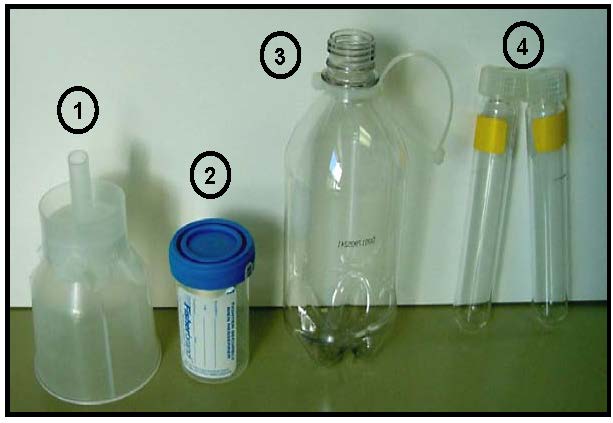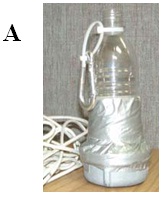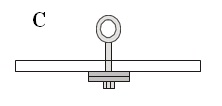Lake Partner Program: Sampling Instructions
Water sampling instructions for Lake Partner Program volunteers.
Spring Sampling Instructions, 2012
General
Lakes on the Canadian Shield are sampled for total phosphorus once per year during May.
Because the transparency of a lake may vary through the year, Secchi disk observations are made, ideally, twice per month from May to October. Record the Secchi depths on the enclosed observation sheet. Refer to the sampling instructions on the reverse side of the Secchi observation sheet while sampling. In November, return the Secchi observation sheet to the Dorset Environmental Science Centre in the pre-paid envelope provided.
Please read these detailed instructions and the Secchi observation sheet before you sample.
Before you sample
Water Sampling Materials include:
- one 80 micron funnel with filter (1)
- one small blue-capped sample jar (2)
- one sample collection bottle (3)
- two glass sample tubes (4)
- Secchi observation sheet and return envelope, return postage for samples with Dorset mailing address

Note: You will need to supply some materials to make a collection bottle and Secchi Disk.
- Prepare the collection bottle by attaching about 6 meters of clean rope to the neck ring (photo A). Mark the rope off in metres. Duct tape the bottle to a suitable clean weight that is heavy enough to sink it. A metal pipe cap is shown in the photo below (A). Keep your ropes and weights to attach to a new bottle that is supplied each year.
- Assemble the Secchi disk. A rope will need to be attached to the Secchi disk enclosed in your kit (for new volunteers). The rope length will depend on how transparent the lake is, but in general, lakes in Ontario have up to 10 metres of water clarity (usually 4-6 metres). Mark the rope off in tenths of a metre (photo B). You will need to add an eye bolt (for the rope) and a few large washers, or other suitable weight, to the bottom (photo C). Some stores carry large square “dock hardware” washers that are ideal to use as weights.



Please keep your Secchi Disk to use in following years. With time, some rope material will stretch. Each year check that the metre markings on the collection bottle rope and the tenths of a metre markings on the Secchi disk rope are still accurate.
At the lake
Step 1. Secchi Transparency Readings
- Use your Secchi disk to measure the water clarity and record the depth (in metres) on the observation sheet (see instructions on how to take a Secchi measurement on the back of the field observation sheet).
- Keep your observation sheet to make Secchi readings once or twice per month and return it to Dorset in November in the envelope provided.
Step 2. Collect the Water Samples
- First, write the sampling date on the two tube labels and on the blue capped jar label.
- Rinse the weighted sample bottle twice with surface water. Next, lower the weighted sample bottle down to the Secchi depth and back up to the surface to fill it. In shallow lakes, lower the bottle no closer than 1 metre from the lake bottom.
Step 3. Fill the Small Blue-Capped Jar
- Pour the water sample through the filter and rinse the small sample jar twice with filtered water. Then, fill the small sample jar with filtered water.
- The filter components are held together by friction. If they come apart, reassemble the two halves with the filter screen between the upper and lower sections.
Step 4. Fill the Glass Sample Tubes
- Repeat the sample process (Step 2) to collect water to fill the glass sample tubes.
- Rinse the tubes twice with filtered water before filling.
- Using filtered water, fill each tube to 1 cm above the etched line on the glass sample tube.
- Make sure the lids are screwed on snugly.
Step 5. Mail the samples to Dorset
- Place the funnel, sample collection bottle, small blue-capped jar and glass tubes back into the box.
- Make sure the tubes are inserted back into the protective pipe wrap with the lids securely screwed on. Attach the address label and postage provided to the outside of the box. Do not tape the box closed. The boxes are reused each year and must remain in good condition. Please keep the samples refrigerated until the kit is mailed to Dorset.
Questions - 1-800-470-8322 (or 705-766-1294 if outside Ontario) or email lakepartner@ontario.ca